Anisotropy in Thermal Recovery of Oil Shale—Part 1: Thermal Conductivity, Wave Velocity and Crack Propagation
Abstract
:1. Introduction
2. Materials and Methods
2.1. Description of Oil Shale Samples
2.2. Experimental Process
2.2.1. Thermal Conductivity Experiment
2.2.2. Wave Velocity Test Experiment
2.2.3. Crack Propagation Experiment
3. Results
3.1. Anisotropy of Thermal Conductivity
3.2. Anisotropy of Wave Velocity
3.3. Anisotropy of Crack Propagation
3.4. Variation of Anisotropy Coefficient
4. Discussion
4.1. Reason for the Evolution of Anisotropy of Thermal Conductivity and Wave Velocity
4.2. Correlation between Thermal Conductivity and P-Wave Velocity
4.3. Experimental Application of the Thermal Recovery of Oil Shale
5. Conclusions
- (1)
- Variation in the thermal and physical characteristics perpendicular to the bedding plane can be divided into three phases: (1) from room temperature to 350 °C, the thermal and physical characteristics linearly decreased with the increase in temperature; (2) from 350 °C to 500 °C, thermal and physical characteristics decreased up to 400 °C; (3) thermal and physical characteristics had no obvious change in this phase and values are constant. The variation of the thermal and physical characteristics parallel to the bedding planes can be divided into two phases: (1) from room temperature to 500 °C, the thermal and physical characteristics had a sustained linear decline and the thermal and physical characteristics had no obvious decrease; (2) from 500 °C to 600 °C, the thermal and physical characteristics had no obvious change and finally the value was maintained constant.
- (2)
- Thermal cracks caused by the temperature increase were the main cause for the change of anisotropy ratio and of the thermal and physical characteristics of oil shale. When the temperature reached 400 °C, the number of cracks along the bedding directions increased along with the anisotropy ratio of the thermal and physical characteristics. 400 °C is considered to be the threshold temperature where the change of anisotropy in thermal and physical characteristics occurs.
- (3)
- The variation of thermal conductivity both perpendicular and parallel to the bedding planes with wave velocity can be expressed as Equations (3) and (4). The thermal conductivity has a linear relation with the P-wave velocity.
Acknowledgments
Author Contributions
Conflicts of Interest
References
- Burger, J.W.; Crawford, P.M.; Johnson, H.R. Is oil shale America’s answer to peak-oil challenge? Oil Gas J. 2004, 102, 16–24. [Google Scholar]
- Liu, Z.J.; Dong, Q.S.; Ye, S.Q.; Zhu, J.W.; Guo, W.; Li, D.C.; Liu, R.; Zhang, H.L.; Du, J.F. The situation of oil shale resources in China. J. Jilin Univ. (Earth Sci. Ed.) 2006, 36, 869–876, (In Chinese with English abstract). [Google Scholar]
- Vinegar, H. Shell’s in-situ conversion process. In Proceedings of the 26th Oil Shale Symposium, Colorado School of Mines, Golden, CO, USA, 16–18 October 2006; Colorado Energy Research Institute: Golden, CO, USA, 2006. [Google Scholar]
- Kang, Z.Q.; Zhao, Y.S.; Yang, D. Physical principle and numerical analysis of oil shale development using in-situ conversion process technology. Acta Pet. Sin. 2008, 29, 592–595. (In Chinese) [Google Scholar]
- Hillier, J.L.; Fletcher, T.H.; Solum, M.S.; Pugmire, R.J. Characterization of Macromolecular Structure of Pyrolysis Products from a Colorado Green River Oil Shale. Ind. Eng. Chem. Res. 2013, 52, 15522–15532. [Google Scholar] [CrossRef]
- Sun, Y.; Bai, F.; Liu, B.; Liu, Y.; Guo, M.; Guo, W.; Wang, Q.; Lu, X.; Yang, F.; Yang, Y. Characterization of the oil shale products derived via topochemical reaction method. Fuel 2014, 115, 338–346. [Google Scholar] [CrossRef]
- Vernik, L.; Nur, A. Ultrasonic velocity and anisotropy of hydrocarbon source rocks. Geophysics 1992, 57, 727–735. [Google Scholar] [CrossRef]
- Vernik, L.; Landis, C. Elastic anisotropy of source rocks: Implications for hydrocarbon generation and primary migration. AAPG Bull. 1996, 80, 531–544. [Google Scholar]
- Amadei, B. Importance of anisotropy when estimating and measuring in situ, stresses in rock. Int. J. Rock Mech. Min. Sci. Geomech. Abstr. 1996, 33, 293–325. [Google Scholar] [CrossRef]
- Saboorian-Jooybari, H.; Dejam, M.; Chen, Z. Heavy oil polymer flooding from laboratory core floods to pilot tests and field applications: Half-century studies. J. Pet. Sci. Eng. 2016, 142, 85–100. [Google Scholar] [CrossRef]
- Saboorian-Jooybari, H.; Dejam, M.; Chen, Z. Half-century of heavy oil polymer flooding from laboratory core floods to pilot tests and field applications. In Proceedings of the 2015 SPE Canada Heavy Oil Technical Conference (Paper SPE 174402), Calgary, AB, Canada, 9–11 June 2015. [Google Scholar]
- Mashayekhizadeh, V.; Kord, S.; Dejam, M. Eor Potential within Iran. Spec. Top. Rev. Porous Media 2014, 5, 325–354. [Google Scholar] [CrossRef]
- Sun, Q.; Lü, C.; Cao, L.; Li, W.; Geng, J.; Zhang, W. Thermal properties of sandstone after treatment at high temperature. Int. J. Rock Mech. Min. Sci. 2016, 85, 60–66. [Google Scholar] [CrossRef]
- Vosteen, H.D.; Schellschmidt, R. Influence of temperature on thermal conductivity, thermal capacity and thermal diffusivity for different types of rock. Phys. Chem. Earth Parts A B C 2003, 28, 499–509. [Google Scholar] [CrossRef]
- Jha, M.K.; Verma, A.K.; Maheshwar, S.; Chauhan, A. Study of temperature effect on thermal conductivity of Jhiri shale from Upper Vindhyan, India. Bull. Eng. Geol. Environ. 2016, 75, 1657–1668. [Google Scholar] [CrossRef]
- Hajpál, M.; Török, A. Mineralogical and colour changes of quartz sandstones by heat. Environm. Geol. 2004, 46, 311–322. [Google Scholar] [CrossRef]
- Zhao, J.; Yang, D.; Kang, Z.; Feng, Z. A micro-CT study of changes in the internal structure of Daqing and Yan’an oil shales at high temperatures. Oil Shale 2012, 29, 357–367. [Google Scholar] [CrossRef]
- Yang, L.; Yang, D.; Zhao, J.; Liu, Z.; Kang, Z. Changes of oil shale pore structures and permeability at different temperatures. Oil Shale 2016, 33, 101–110. [Google Scholar] [CrossRef]
- Dejam, M.; Hassanzadeh, H.; Chen, Z. Pre-Darcy flow in porous media. Water Resour. Res. 2017, 53, 8187–8210. [Google Scholar] [CrossRef]
- Tiwari, P.; Deo, M.; Lin, C.L.; Miller, J.D. Characterization of oil shale pore structure before and after pyrolysis by using X-ray micro CT. Fuel 2013, 107, 547–554. [Google Scholar] [CrossRef]
- Bai, F.; Sun, Y.; Liu, Y.; Guo, M. Evaluation of the porous structure of Huadian oil shale during pyrolysis using multiple approaches. Fuel 2017, 187, 1–8. [Google Scholar] [CrossRef]
- Junwei, Y.; Xiumin, J.; Xiangxin, H.; Jianguo, L. A TG-FTIR investigation to the catalytic effect of mineral matrix in oil;shale on the pyrolysis and combustion of kerogen. Fuel 2013, 104, 307–317. [Google Scholar]
- Kang, Z.; Yang, D.; Zhao, Y.; Hu, Y.Q. Thermal cracking and corresponding permeability of Fushun oil shale. Oil Shale 2011, 28, 273–283. [Google Scholar] [CrossRef]
- Meng, Q.R.; Kang, Z.Q.; Zhao, Y.S.; Dong, Y. Experiment of thermal cracking and crack initiation mechanism of oil shale. Zhongguo Shiyou Daxue Xuebao 2010, 34, 89–92. [Google Scholar]
- Diansen, Y.; Chanchole, S.; Valli, P.; Chen, L. Study of the Anisotropic Properties of Argillite under Moisture and Mechanical Loads. Rock Mech. Rock Eng. 2013, 46, 247–257. [Google Scholar]
- Masri, M.; Sibai, M.; Shao, J.F.; Mainguy, M. Experimental investigation of the effect of temperature on the mechanical behavior of Tournemire shale. Int. J. Rock Mech. Min. Sci. 2014, 70, 185–191. [Google Scholar] [CrossRef]
- Kim, H.; Cho, J.W.; Song, I.; Min, K.B. Anisotropy of elastic moduli, P-wave velocities, and thermal conductivities of Asan Gneiss, Boryeong Shale, and Yeoncheon Schist in Korea. Eng. Geol. 2012, 147–148, 68–77. [Google Scholar] [CrossRef]
- Cho, J.W.; Kim, H.; Jeon, S.; Min, K.B. Deformation and strength anisotropy of Asan gneiss, Boryeong shale, and Yeoncheon schist. Int. J. Rock Mech. Min. Sci. 2012, 50, 158–169. [Google Scholar] [CrossRef]
- Özkahraman, H.T.; Selver, R.; Işık, E.C. Determination of the thermal conductivity of rock from P-wave velocity. Int. J. Rock Mech. Min. Sci. 2004, 41, 703–708. [Google Scholar] [CrossRef]
- Saif, T.; Lin, Q.; Singh, K.; Bijeljic, B.; Blunt, M.J. Dynamic imaging of oil shale pyrolysis using synchrotron X-ray microtomography. Geophys. Res. Lett. 2016, 43, 6799–6807. [Google Scholar] [CrossRef]
- Saif, T.; Lin, Q.; Bijeljic, B.; Blunt, M.J. Microstructural imaging and characterization of oil shale before and after pyrolysis. Fuel 2017, 197, 562–574. [Google Scholar] [CrossRef]
- Parker, W.J.; Jenkins, R.J.; Butler, C.P.; Abbott, G.L. Flash Method of Determining Thermal Diffusivity, Heat Capacity, and Thermal Conductivity. J. Appl. Phys. 1961, 32, 1679–1684. [Google Scholar] [CrossRef]
- Qian, J.L.; Yin, L. Oil Shale—The Supply Resource for Petroleum; Petrochemical Press: Beijing, China, 2008; pp. 50–51. (In Chinese) [Google Scholar]
- Zhao, Y.X.; Yang, S.Z.; Zhang, W.R.; Ma, L. An experimental study of rock thermal conductivity under different temperature and pressure. Prog. Geophys. 1995, 10, 104–113. [Google Scholar]
- Kingery, W.D. Factors Affecting Thermal Stress Resistance of Ceramic Materials. J. Am. Ceram. Soc. 1955, 38, 3–15. [Google Scholar] [CrossRef]
- Nagaraju, P.; Roy, S. Effect of water saturation on rock thermal conductivity measurements. Tectonophysics 2014, 626, 137–143. [Google Scholar] [CrossRef]
- Yu, Y. Reasearch on Fracture and Damage Behaviour of Oil Shale under Thermal-Mechanical Coupling Field; Taiyuan University of Technology: Taiyuan, China, 2015. (In Chinese) [Google Scholar]
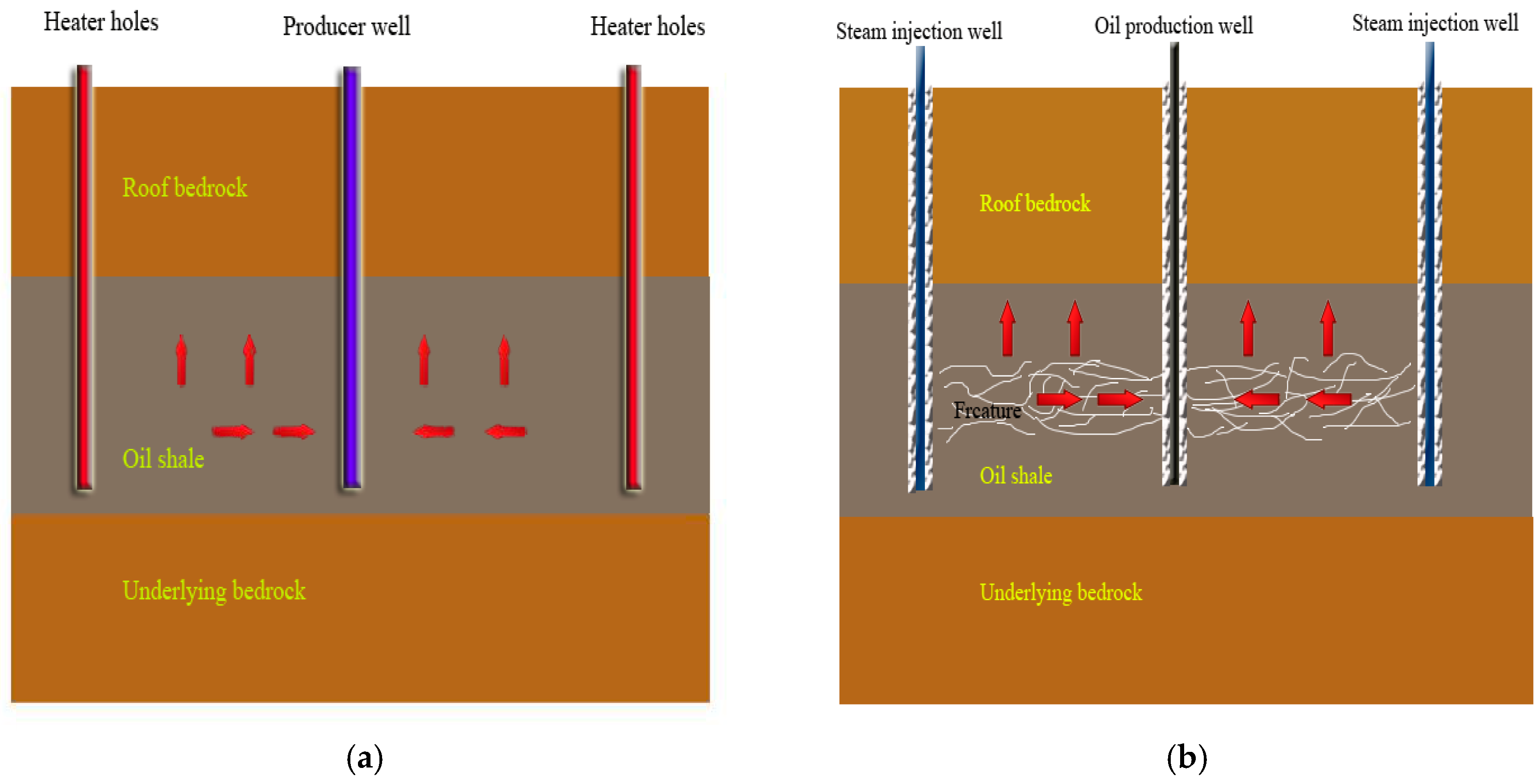
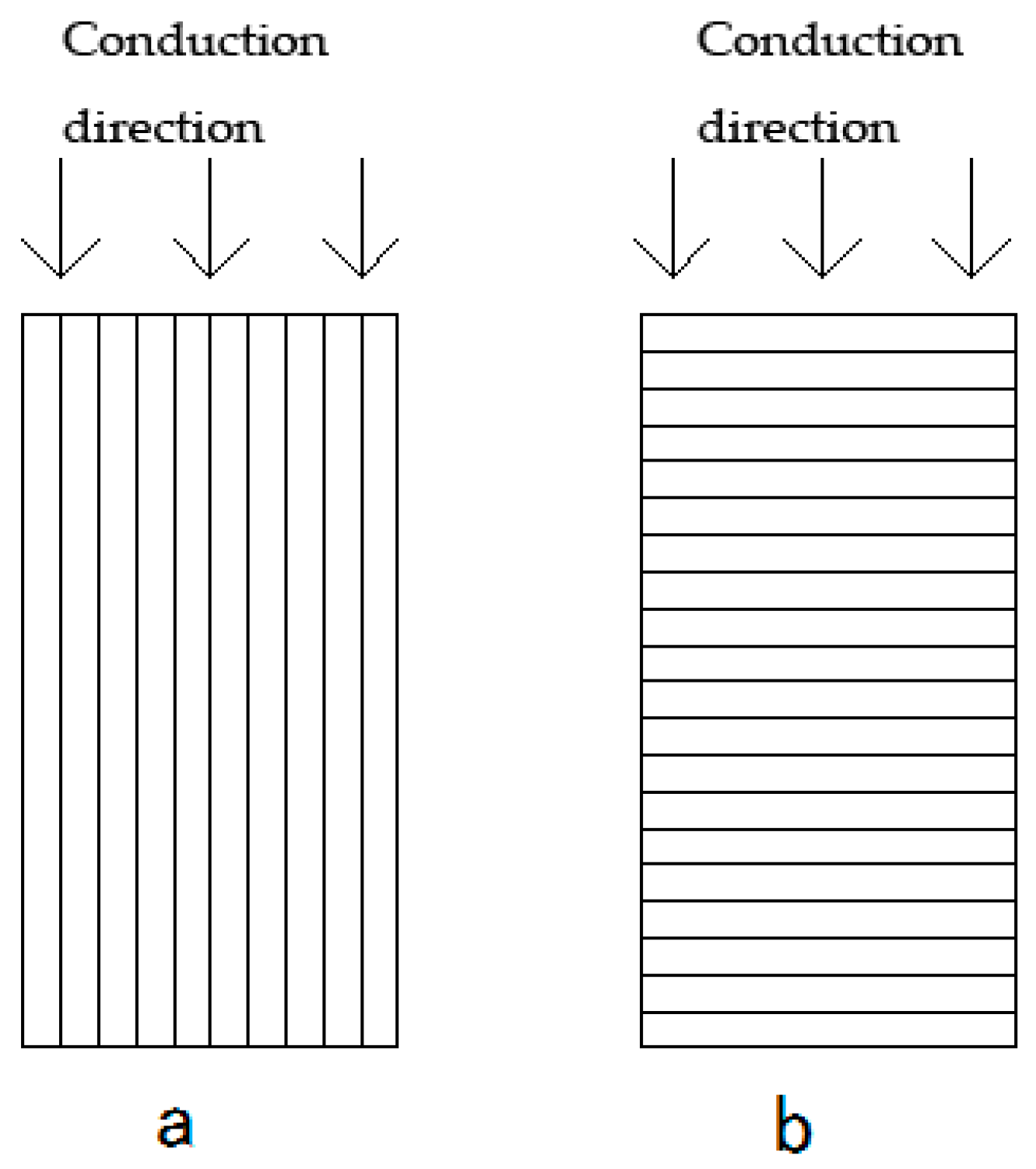

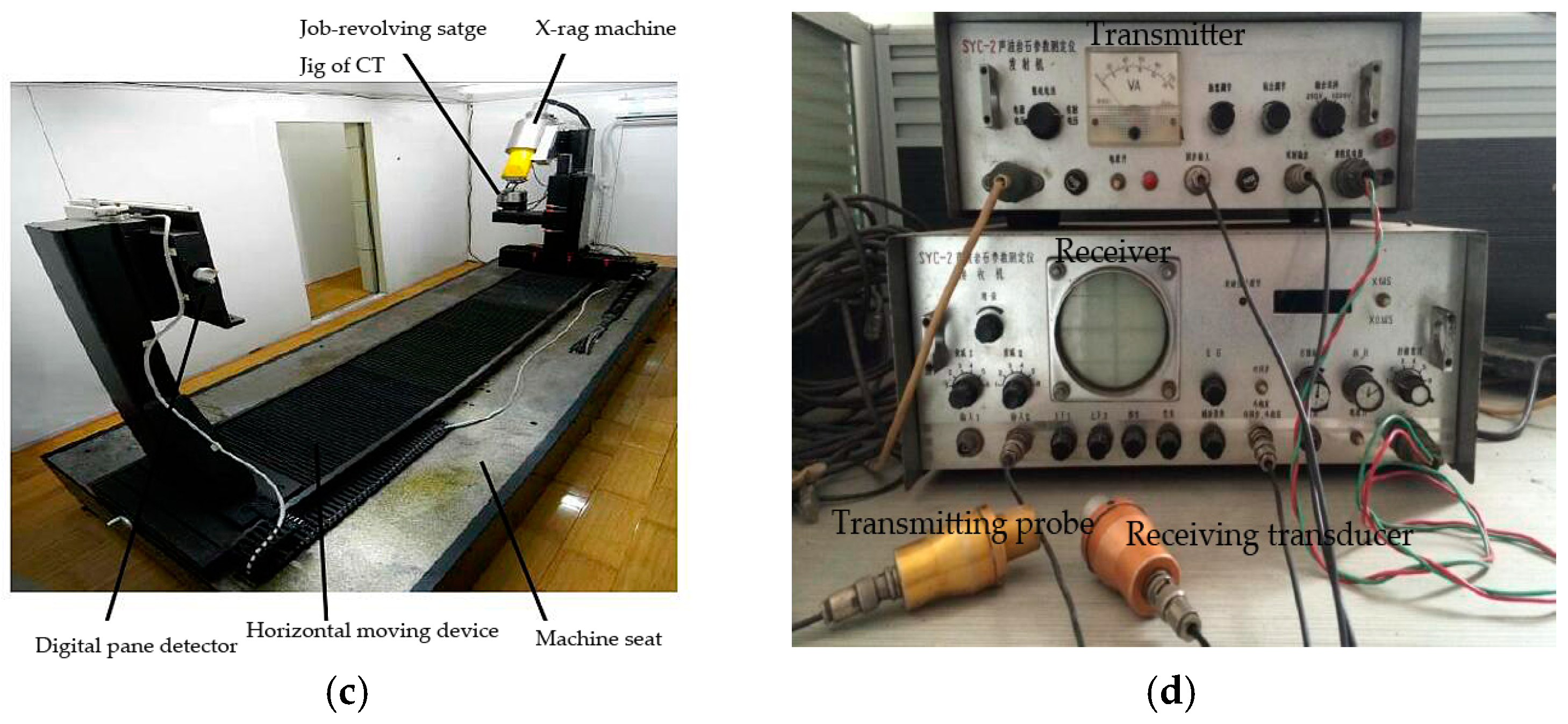
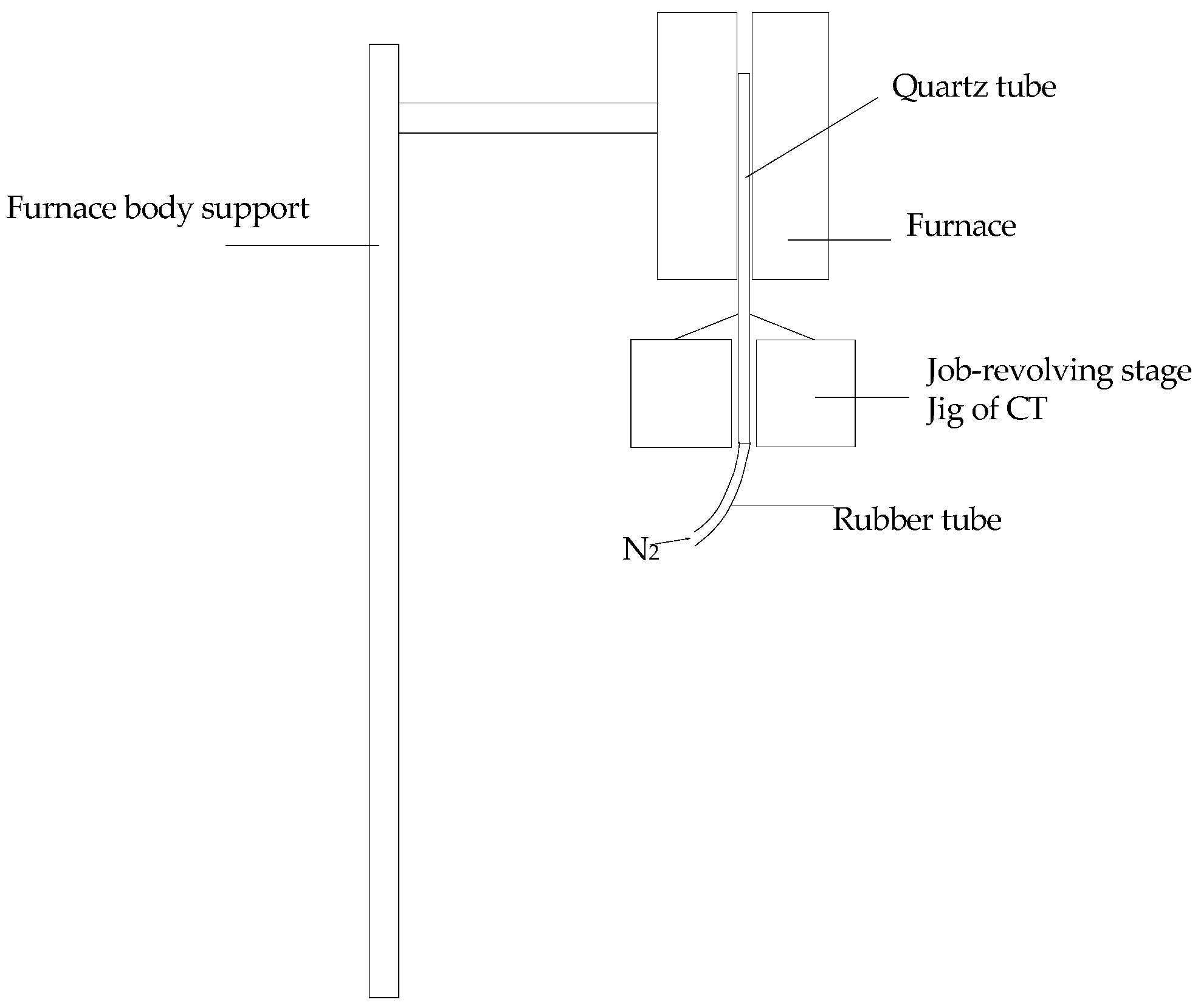

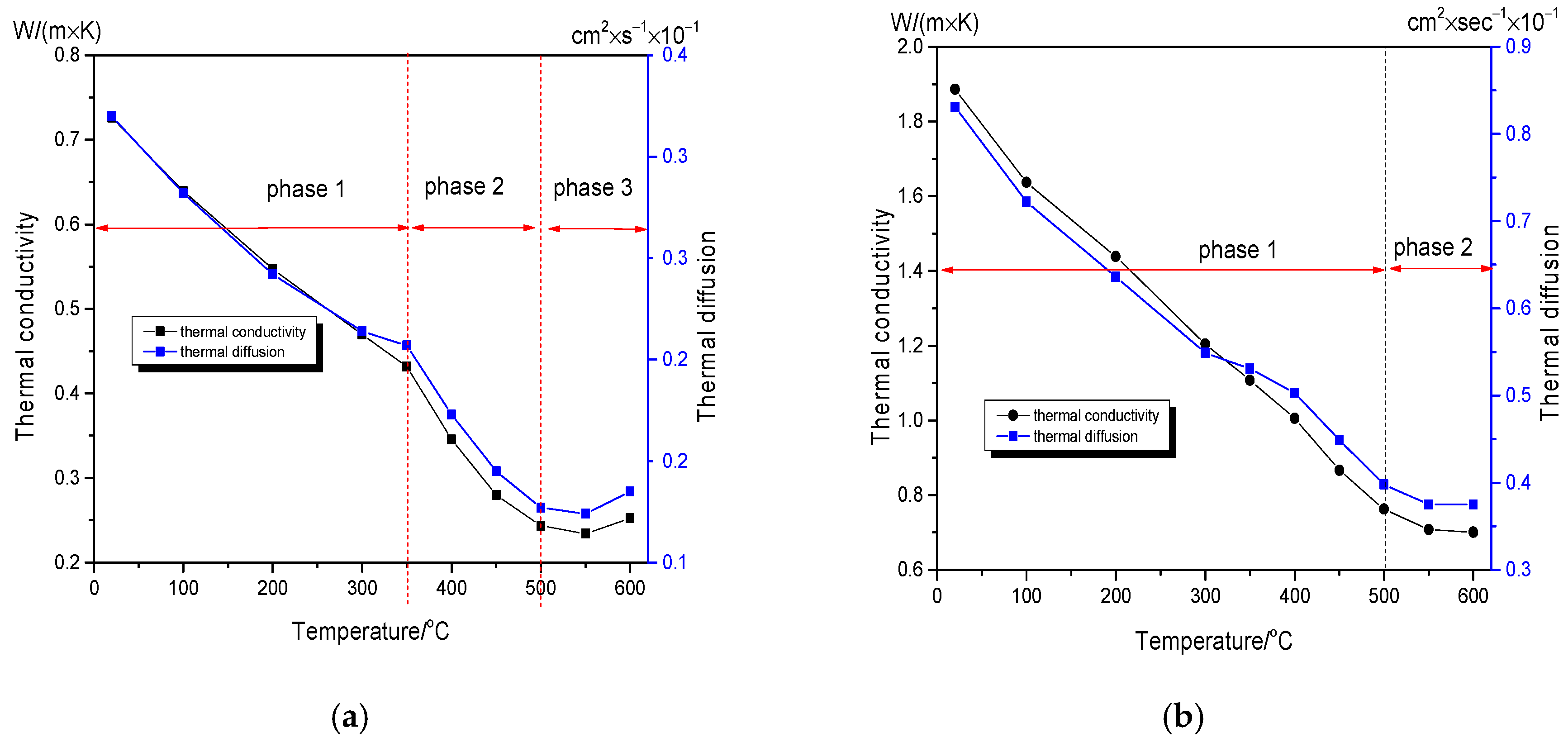
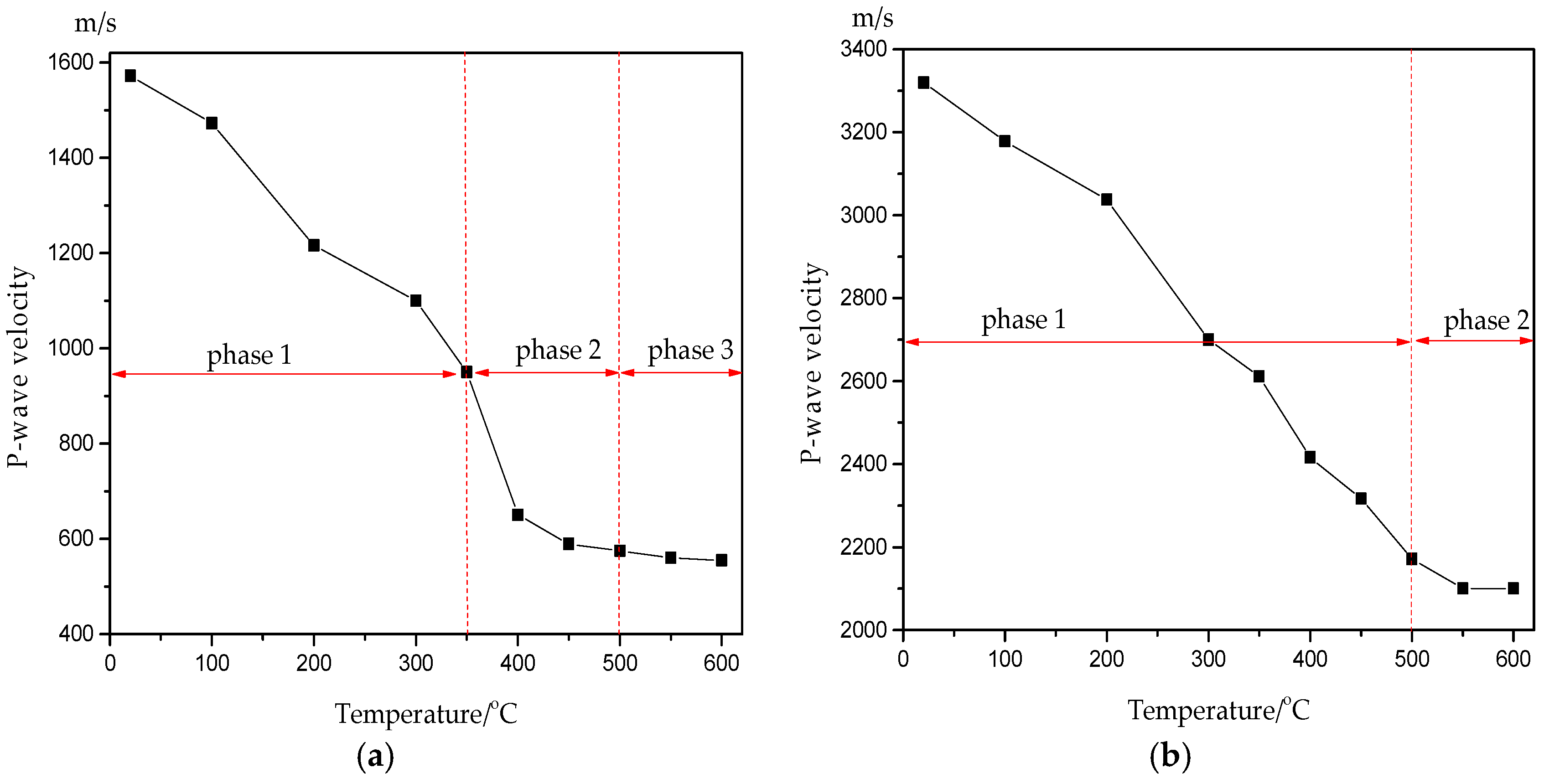
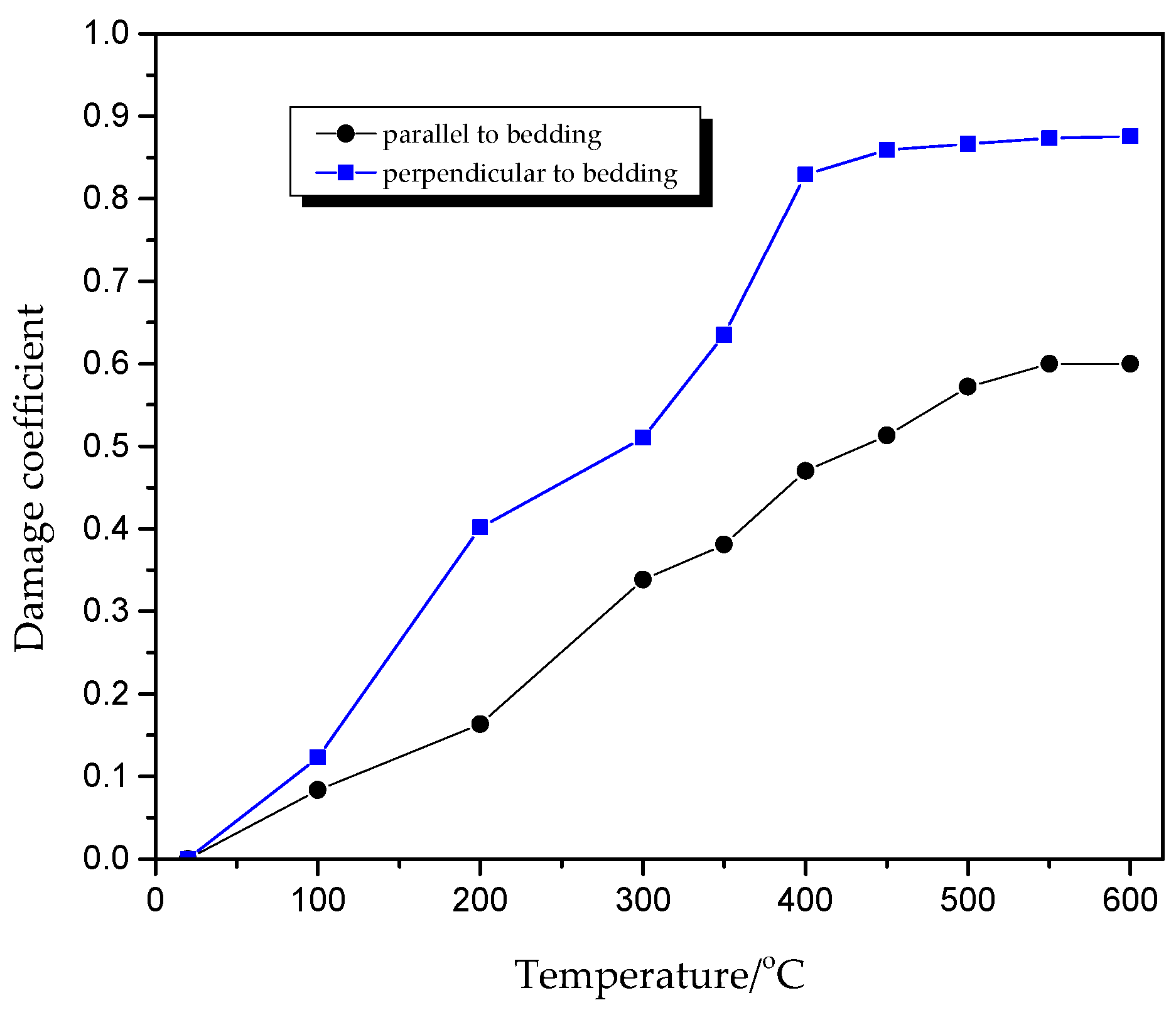
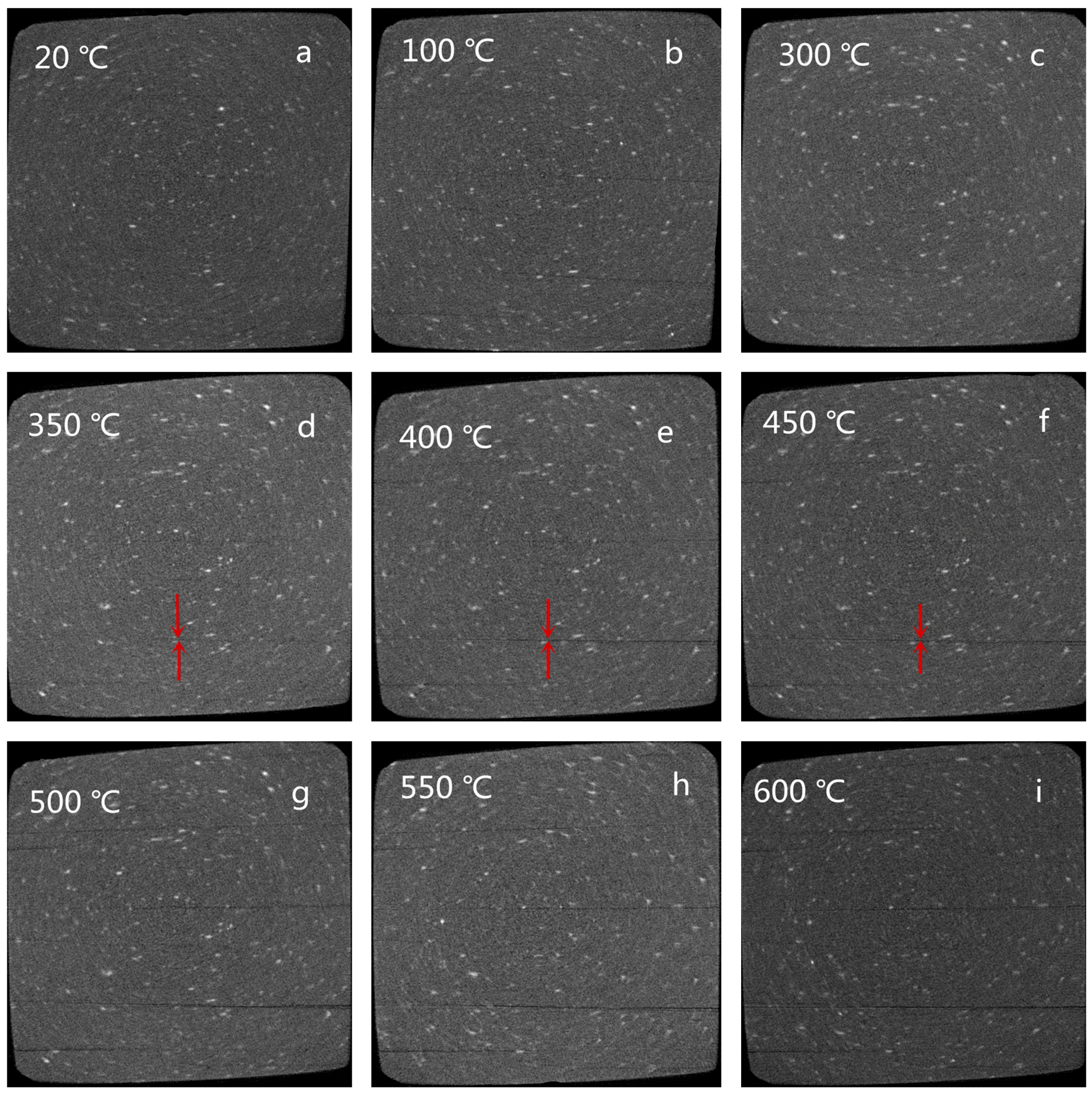
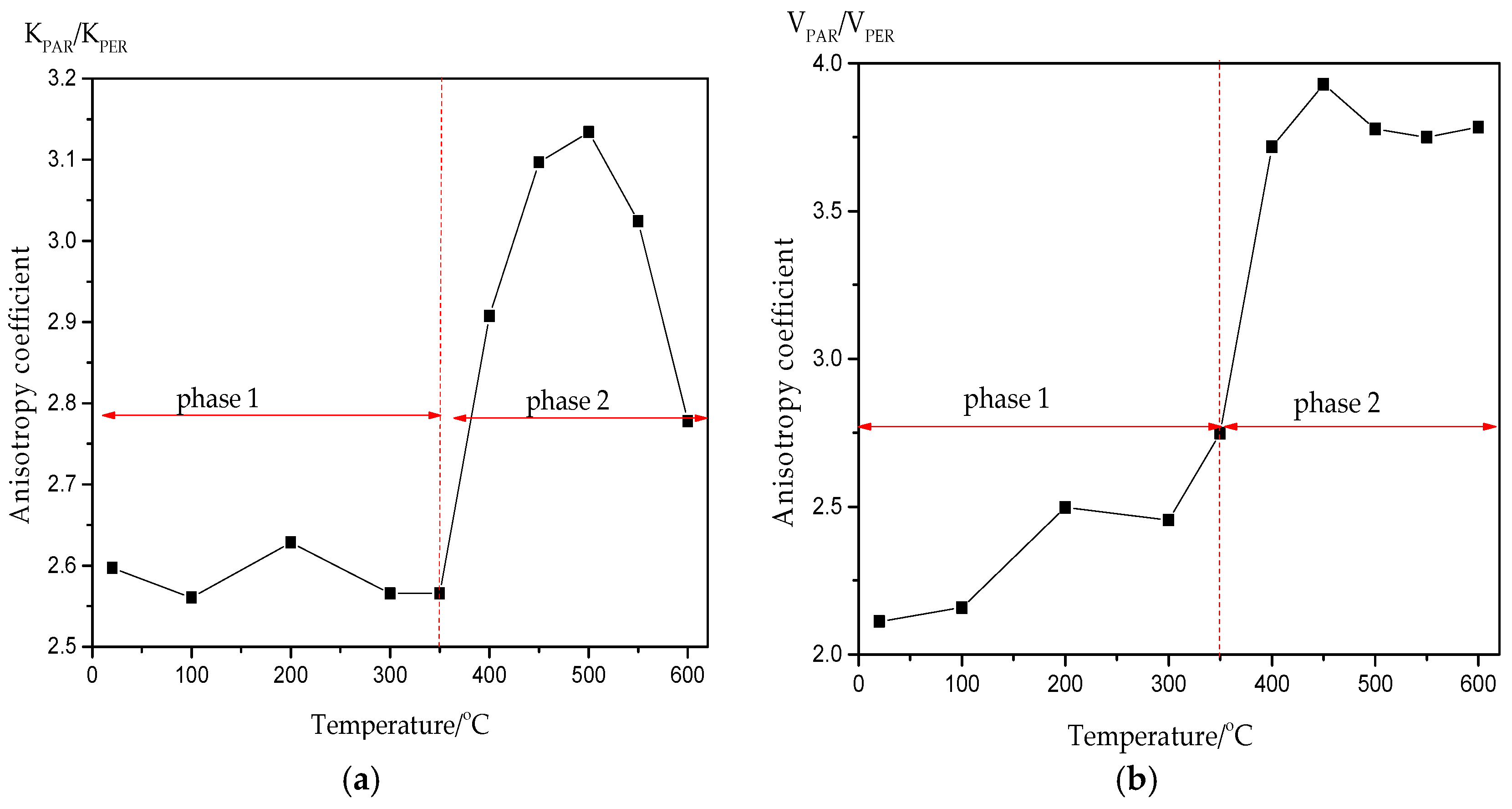
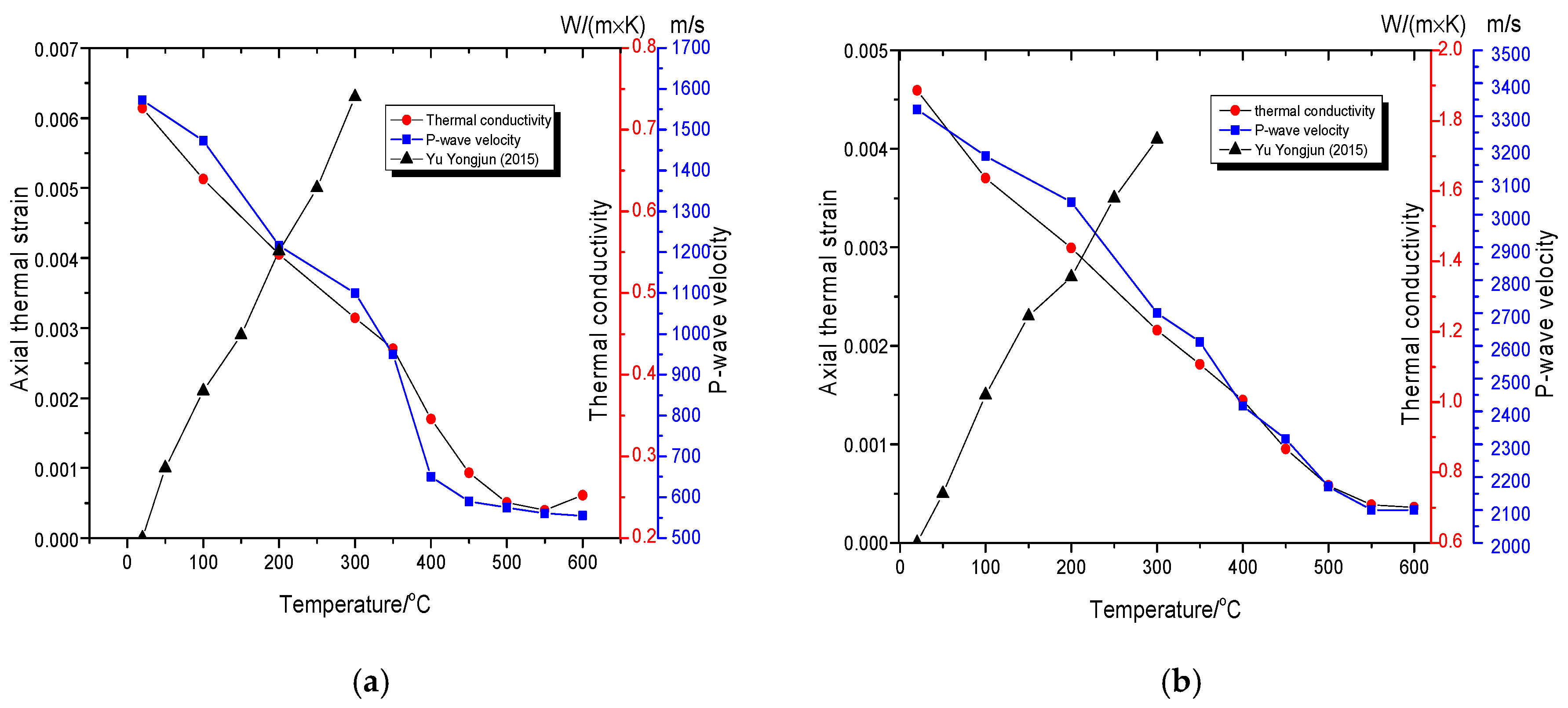
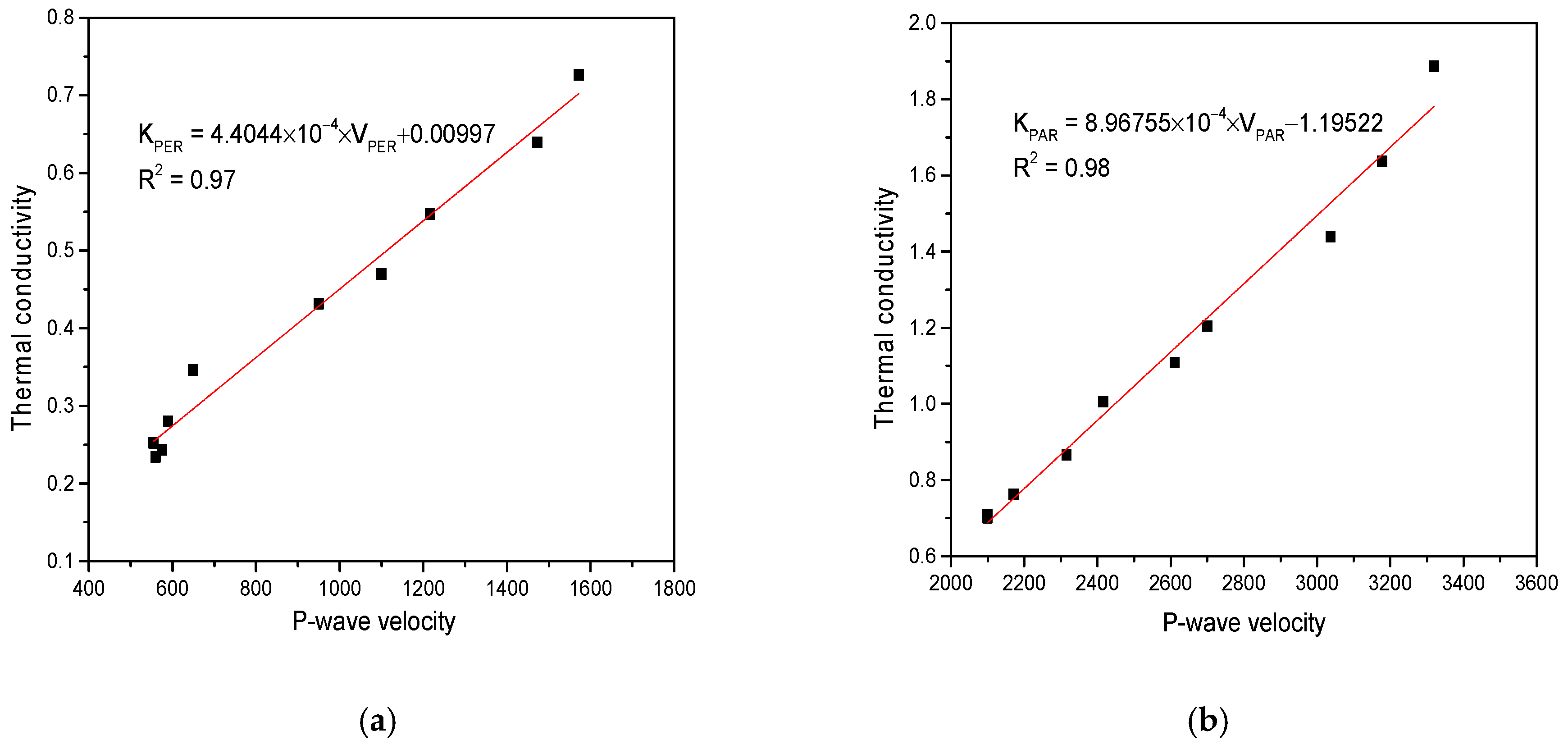
| Experiment | Thermal Diffusion | DSC–TG | Wave Velocity | CT Scanning |
|---|---|---|---|---|
| Sample shape | Block | Cylinder | Cylinder | Block |
| Size | 10 × 10 × 2 mm | 5 × 1 mm | 10 × 25 mm | 7 × 7 × 7 mm |
| Sample bedding plane | Perpendicular and parallel to bedding plane | - | Perpendicular and parallel to bedding plane | Perpendicular and parallel to bedding plane |
| Calculation Coefficients | 20 °C | 100 °C | 200 °C | 300 °C | 350 °C | 400 °C | 450 °C | 500 °C | 550 °C | 600 °C | |
|---|---|---|---|---|---|---|---|---|---|---|---|
| Thermal diffusion | DPER | 0.32 | 0.282 | 0.242 | 0.214 | 0.207 | 0.173 | 0.145 | 0.127 | 0.124 | 0.135 |
| DPAR | 0.831 | 0.722 | 0.636 | 0.549 | 0.531 | 0.503 | 0.449 | 0.398 | 0.375 | 0.375 | |
| Density (g/cm3) | 2.176 | 2.174 | 2.168 | 2.103 | 2.01 | 1.917 | 1.852 | 1.838 | 1.811 | 1.792 | |
| Thermal conductivity | KPER | 0.726 | 0.639 | 0.547 | 0.469 | 0.431 | 0.356 | 0.279 | 0.243 | 0.234 | 0.252 |
| KPAR | 1.886 | 1.637 | 1.438 | 1.204 | 1.108 | 1.006 | 0.866 | 0.763 | 0.708 | 0.701 | |
© 2018 by the authors. Licensee MDPI, Basel, Switzerland. This article is an open access article distributed under the terms and conditions of the Creative Commons Attribution (CC BY) license (http://creativecommons.org/licenses/by/4.0/).
Share and Cite
Wang, G.; Yang, D.; Kang, Z.; Zhao, J. Anisotropy in Thermal Recovery of Oil Shale—Part 1: Thermal Conductivity, Wave Velocity and Crack Propagation. Energies 2018, 11, 77. https://doi.org/10.3390/en11010077
Wang G, Yang D, Kang Z, Zhao J. Anisotropy in Thermal Recovery of Oil Shale—Part 1: Thermal Conductivity, Wave Velocity and Crack Propagation. Energies. 2018; 11(1):77. https://doi.org/10.3390/en11010077
Chicago/Turabian StyleWang, Guoying, Dong Yang, Zhiqin Kang, and Jing Zhao. 2018. "Anisotropy in Thermal Recovery of Oil Shale—Part 1: Thermal Conductivity, Wave Velocity and Crack Propagation" Energies 11, no. 1: 77. https://doi.org/10.3390/en11010077





